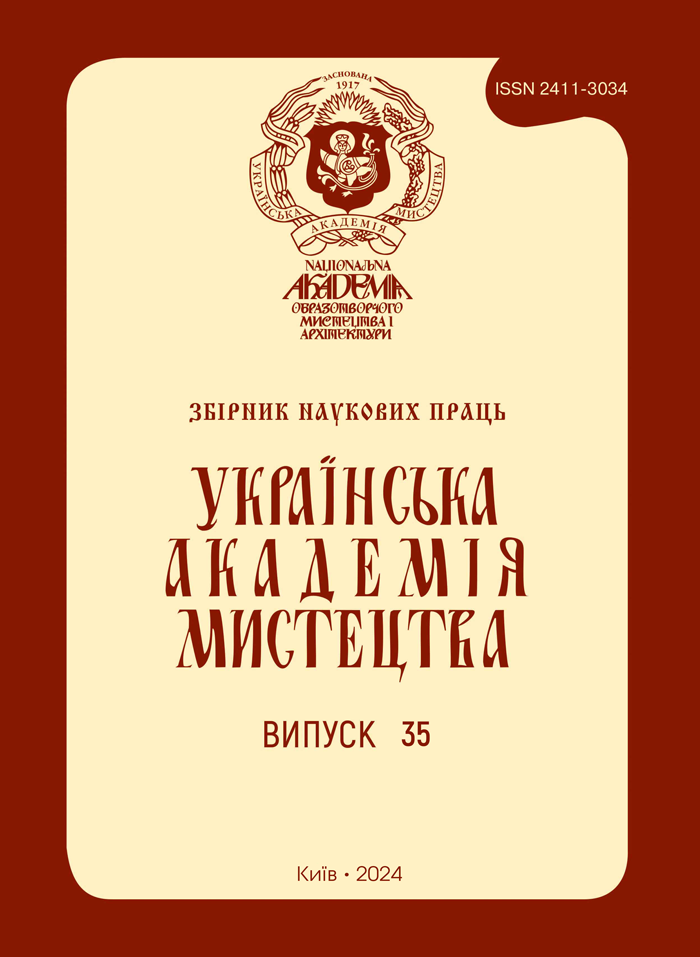THE CONCEPT OF COLOR IN THE CREATIVE PHILOSOPHY OF POST-IMPRESSIONIST ARTISTS
DOI:
https://doi.org/10.32782/2411-3034-2024-35-18Keywords:
post-impressionism, neo-impressionism, chromoluminarism, syntheticism, nabi, symbolismAbstract
The aim of the article is to analyze the main features of the color concept in the creative philosophy of the representatives of post-impressionism: neo-impressionists (chromoluminarists), synthetists and symbolists. Two main approaches to the rethinking of color, which were popular in the late nineteenth and early twentieth centuries, are analyzed: the scientific one, common among the chromoluminarists, and the philosophical one, which was used by the synthetists and symbolists. The defining task of the study is to reveal the coloristic innovation of the Post-Impressionists and its influence on the further development of modern art. Methods are based on the art historical and cultural analysis of the works of Paul Gauguin, Vincent Van Gogh, Paul Cézanne, Pierre Bonnard, Odilon Redon, Felix Vallotton, Paul Ranson and other famous post-impressionists. Results. The main conceptual provisions of the coloristic philosophy of the representatives of Post-Impressionism are determined, the embodiment of this philosophy in individual works of art is analyzed, and the vision of color symbolism by different Post-Impressionist artists is compared. The scientific novelty lies in a comprehensive study of the development of the concept of color in the creative philosophy of the main trends of Post-Impressionism: chromoluminarism, synthesis, including The Nabis group, and symbolism. Conclusions. The results of the research provide convincing arguments in favor of the fact that the fullness of artists' self-expression in color was first achieved in the post-impressionist period. The color philosophy of the Post-Impressionists got rid of the strict canons of academic painting, the requirements for realism, subordination to lighting and the situation inherent in early Impressionism. Therefore, it was able to give rise to the coloristics of many modernist art movements, innovative graphics, and lay the foundation for modern pixel design.
References
Павельчук І. Ідея синтезу мистецтв як історико-культурне підґрунтя концептуальних засад постімпресіонізму. Вісник ХДАДМ : зб. наук. праць. 2016. № 5. С. 37–43.
Павельчук І. На перехресті модерну : інспірації японізму у практиці українських колористів 1900–1930-х років : монографія. Київ : Києво-Могилянська академія, 2019. 224 с.
Павельчук І. Постімпресіонізм в українському живописі ХХ – початку ХХI століття : історичні витоки, джерела інспірацій, специфіка розвитку : дис. … д-ра мистецтвознавства : 17.00.05 /Львів. нац. акад. мистецтв. Львів, 2020. 878 с. URL: https://lnam.edu.ua/files/Academy/nauka/specrada/Dusertacii/2020/november2020/IVA_Doctor.pdf (дата звернення: 02.09.2023).
Шама Т. Деякі аспекти становлення художньої системи постімпресіонізму. Студентський науковий вісник Тернопільського національного педагогічного університету імені Володимира Гнатюка. 2018. № 43. С. 24–25.
Карпенко О. Ремінісценції імпресіонізму у творчості українських авангардистів. Культура і сучасність. 2021 № 1. С. 194–199.
Meier-Graefe J. Impressionisten : Guys – Manet – VanGogh – Pissarro – Cézanne. München ; Leipzig : R. Piper & Co., 1907. 212 р.
Karp-Lugo, L. Du Synthétisme à L’arrière-garde : le Parcours d’Émile Bernard. Émile Bernard. Au-delà de Pont-Aven / ed. Neil McWilliam. Paris : INHA, 2012. 118 p. URL: https://books.openedition.org/inha/4776 (дата звернення: 02.09.2023).
Cole М. Learn about the Colorful Art of French Post-Impressionist Émile Bernard. My Modern Met. 2022, January, 12. URL:. https://mymodernmet.com/emile-bernard-paintings/ (дата звернення: 05.09.2023).
Lovelace A. Beyond Montmartre and the Avant-Garde: Henri de Toulouse-Lautrec and the Democratization of Art. University of Houston, 2022. 86 p. URL: https://uh-ir.tdl.org/bitstream/handle/10657/10480/Lovelace_Arabella_BeyondMontmartre_2022.pdf?sequence=1&isAllowed=y (дата звернення: 02.09.2023).
Geng R. All about Cézanne — A Brief Introduction on Cézanne’s Painting Style and Representative Works. Art and Design Review. 2020. URL: https://www.scirp.org/journal/paperinformation.aspx?paperid=100869 (дата звернення: 02.09.2023).
Krall E. Van Gogh, Nature, and Spirituality. Rollings Scholarship Online. 2021. URL: https://scholarship.rollins.edu/cgi/viewcontent.cgi?article=1001&context=honors-in-the-major-art дата звернення: 02.09.2023).
Schiffer K. Vincent Van Gogh — Man of Art, Man of Faith. National Catholic Register. 2022, January 28. URL: https://www.ncregister.com/blog/vincent-van-gogh-art-faith (дата звернення: 02.09.2023).
Neo-Impressionism. Wikipedia. URL: https://en.wikipedia.org/wiki/Neo-Impressionism (дата звернення: 02.09.2023).
Cramer, С., Grant, K. Neo-Impressionist Color Theory. Khan Academy. URL: https://www.khanacademy.org/humanities/becoming-modern/avant-garde-france/post-impressionism/a/neoimpressionist-color-theory (дата звернення: 02.09.2023).
Renauld, M.-M. Paul Signac: Color Science and Politics in Neo-Impressionism. The Collector. 2021, June 10. URL: https://www.thecollector.com/paul-signac/ (дата звернення: 02.09.2023).
Cloisonnism. History, Characteristics of Expressionist Painting at Pont-Aven School. Encyclopedia of Art History. URL: http://www.visual-arts-cork.com/history-of-art/cloisonnism.htm#pontaven (дата звернення: 07.09.2023).
Arles Y. Cloisonnism is a small episode with a great influence on the development of contemporary art. Vinnie Jinn, 2021, March 24: URL: https://www.vinniejinn.com/post/cloisonnism-is-a-small-episodewith-a-great-influence-on-the-development-of-contemporary-art (дата звернення: 05.09.2023).
Huang X. The influence of Japanese Ukiyo-e on Western painting art in the 19th Century. BCP Social Sciences & Humanities. 2022. № 20. Р. 304–310.
De Watrigant T. Focus on a Work: The Talisman by Paul Sérusier. Art Shortlist, 2021, January 8. URL: https://artshortlist.com/en/journal/article/the-talisman-paul-serusier (дата звернення: 07.09.2023).
Synthetism. Hisour. 2023. URL: https://www.hisour.com/synthetism-35112/ (дата звернення: 07.09.2023).
Spiritualite. La Couleur Est L'endroit où Notre Cerveau et L'univers se Rencontrent. La Croix. 2016. URL: https://www.la-croix.com/Archives/2016-01-13/SPIRITUALITE-La-couleur-est-l-endroitou-notre-cerveau-et-l-univers-se-rencontrent.-2016-01-13-1404174 (дата звернення 05.09.2023).
Schwabsky B. Pierre Bonnard. His Rhythm Was Colour. Tate. 2019. March 14. URL: https://www.tate.org.uk/tate-etc/issue-45-spring-2019/pierre-bonnard-his-rhythm-was-colour-barry-schwabsky дата звернення: 02.09.2023).
Nabis. Van Gogh Museum Amsterdam. 2023: URL: https://www.vangoghmuseum.nl/en/prints/subject/1129/nabis?v=1 (дата звернення: 06.09.2023).
Richman-Abdou K., Cole M. How Japanese Art Influenced and Inspired European Impressionist Artists. My Modern Met. 2022, June 24: URL: https://mymodernmet.com/japanese-art-impressionismjaponisme/(дата звернення: 05.09.2023).
Les Nabis. The Art Story. 2023. URL: https://www.theartstory.org/movement/les-nabis/ (дата звернення: 02.09.2023).
Patel, L. Art Notes: Exploring the Basics of Symbolism in Art. 1st Art Gallery. 2023, June 30. URL: https://www.1st-art-gallery.com/article/art-notes-exploring-the-basics-of-symbolism-in-art/(дата звернення: 24.07.2023).
Davis J. The Spirituality of Vincent Van Gogh. Jacob W. Davis. 2009, June 8. URL: https://jacobadavis.com/2009/06/08/the-spirituality-of-van-gogh/ (дата звернення: 07.09.2023).
The Green Christ, 1889 by Paul Gauguin. Paul Gauguin. 2023. URL: https://www.gauguin.org/thegreen-christ.jsp (дата звернення: 07.09.2023).




